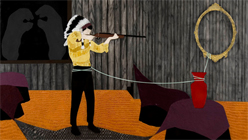
Why are you drawn to a ’70s aesthetic?
“Probably from the materials I’ve worked with — a lot of old family photos, mainly mine, mostly from the ’70s. The colors and Kodachrome in the slides were so influential on me. I loved the way the colors looked, like a flat drab green with a really bright red. It’s always a scheme that appeals to me.”


Tell us more about the found photos you work with.
“I started moving away from family photos and am now doing more animals and hunters, and things like that. I’ll look through Google image search, Ebay is a great source for photos, and now there are a lot of old photo archives online. I still occasionally go through my own family photos to look for a certain positioning of people that seems interesting.”


What else do you look for in the photos?
“When I worked with family photos, I was always looking for the image that was very familiar, like the kids sitting in front of the Christmas tree. Something that was very banal because I felt like many people could relate to it, but it was also fraught with tension and memories. Even though everyone’s smiling, maybe there’s something bad going on. I don’t do a lot of facial details, so I chose iconic images that were so loaded, they could mean different things to different people. A lot of my drawings are composites of different photos, but I’m still looking for a tense moment where you’re wondering what’s going to happen next, or what happened right before that.”


Is there a specific reason why you’re focusing on those types of moments?
“I’m still exploring the themes I’m trying to get at the root of. I like the idea of making something that’s really pretty, like a pretty drawing of a bear and some people, or a really richly colored interior. But the layers of what I’m exploring have dark undertones, sort of like the contrast of the paint and the charcoal — the contrast between these beautiful things. On the surface they seem very simple and normal, but there’s always something dark underlying them.”

Why do you choose to make your figures faceless?
“I like the ambiguity of it and the anonymity. When I use people in my work, I want them to be unidentifiable. I don’t want you to know the emotion that would be on their faces. I want it to be conveyed through gesture, and I want them to be sort of drones — just representations of people doing things, not actual individual people.”


Any artists you look up to?
“I worked with Bill Owens, the photographer. I really like that he’s had so much success but he does things his own way.”


What music could best describe your work?
“The first thing that comes to mind is Kraftwerk — something very cold and German because the people in my paintings are faceless and kind of robotic.”
Catherine Ryan is giving an artist talk at Timken Hall on CCA’s San Francisco campus on October 8th and is in a show, Alluring Subversions at the Oliver Art Center on the Oakland campus opening October 18th. Also catch her in a group show, Highly Contagious at Gallery Hijinks through October 9th.
















